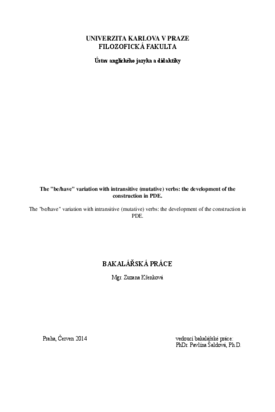The "be/have" variation with Intransitive (mutative) verbs: the development of the construction in PDE
Variace pomocných sloves "be/have" v perfektivní konstrukci netranzitivních sloves: vývoj v současné angličtině
bakalářská práce (OBHÁJENO)

Zobrazit/
Trvalý odkaz
http://hdl.handle.net/20.500.11956/65834Identifikátory
SIS: 137768
Kolekce
- Kvalifikační práce [23740]
Autor
Vedoucí práce
Oponent práce
Tichý, Ondřej
Fakulta / součást
Filozofická fakulta
Obor
Anglistika - amerikanistika
Katedra / ústav / klinika
Ústav anglického jazyka a didaktiky
Datum obhajoby
23. 6. 2014
Nakladatel
Univerzita Karlova, Filozofická fakultaJazyk
Angličtina
Známka
Velmi dobře
Klíčová slova (česky)
perfektum, jazyková změna, syntaxKlíčová slova (anglicky)
perfective, language change,syntaxPerfektní konstrukci intranzitivních sloves, která vedle převažujícího pomocného slovesa have v minulosti užívala i pomocné sloveso be, byla dosud věnována pozornost z hlediska především historické lingvistiky s důrazem na vývoj mezi 17. a 19. stoletím, kdy došlo k výraznému ústupu be ve prospěch slovesa have. Tato práce se naopak chce zaměřit především na vývoj v současné angličtině (resp. v širším pojetí na vývoj ve 20. století). Teoretická část práce má především vytvořit podklad pro část výzkumnou, tj. uvést přístupy a závěry dosavadního výzkumu a vytvořit přehled užívané terminologie. Výzkumná část se skládá ze dvou částí. Na základě korpusové rešerše ověřuje výskyt vybrané skupiny sloves v současné angličtině. Protože se jedná o poměrně řídce se vyskytující konstrukci, tak vedle Britského národního korpusu a Korpusu současné americké angličtiny je použit také mnohem rozsáhlejší internetový korpus UkWaC. Nalezený vzorek je dále použit k další analýze, především s ohledem na distribuci z hlediska žánru, kolokací a jazykové variety.
So far the perfective construction of intransitive verbs, which apart from the dominant auxiliary verb have occurred in the past also the auxiliary be, has been analysed especially from the diachronic point of view focusing on the period between the 17th and 19th centuries, when the majority of verbs ceased to be used with the be marker. The present study deals with the occurrence of the be perfective construction in the contemporary English, i.e. the 20th century English. Drawing on grammars and previous studies, the theoretical part of the thesis provides an overview of the present approaches to the issue, presents the conclusions drawn from the analyses of the diachronic material as well as overview of important terms. The research project consists of two parts: drawing from the corpora search the first part assembled the evidence for a group of intransitive verbs and also attested under what conditions a labile verb might acquire the perfective reading. As the be perfective might be considered a fairly rare construction, not only the British National Corpus and the Corpus of Contemporary American English were used but also the web corpus of a considerably larger size. The collected database was used for further analysis related to genre categories, co-occurrence patterns and language variety.
